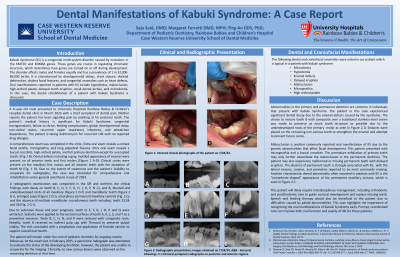Syndromes/Craniofacial Anomalies
265 - Dental Manifestations of Kabuki Syndrome: A Case Report


Saja M. Said, DMD
Pediatric Dental Resident
Case Western Reserve University — UH Rainbow Babies and Children’s Hospital, Cleveland, OH
Case Western Reserve University
Fairview Park, Ohio, United States- MF
Margaret Elaine Ferretti, DMD
Program Director
Case Western Reserve University- University Hospitals Rainbow Babies and Children's
Rainbow Babies and Children's Hospitals, Case Western Reserve University
Cleveland, Ohio, United States - MF
Margaret Elaine Ferretti, DMD
Program Director
Case Western Reserve University- University Hospitals Rainbow Babies and Children's
Rainbow Babies and Children's Hospitals, Case Western Reserve University
Cleveland, Ohio, United States
Presenting Author(s)
Co-Author(s)
Program Director(s)
Kabuki syndrome is a congenital multi-system disorder caused by mutations in the KMT2D and KDM6A genes. The disorder effects males and females equally and has a prevalence of 1 in 32,000-86,000 births. It is characterized by developmental delays, short stature, skeletal deformities, and distinct facial features. Oral manifestations reported in patients with Kabuki Syndrome include hypodontia, malocclusion, high-arched palate, delayed tooth eruption, small dental arches, and microdontia. Less commonly, cleft lip/palate and bifid tongue/uvula have been reported.
This case describes a 4-year-old male who presented to University Hospitals Rainbow Babies and Children’s Hospital for comprehensive dental treatment under general anesthesia. The patient’s medical history is significant for Kabuki Syndrome, presenting with multiple characteristics associated with the syndrome including global developmental delay. His dental exam revealed enamel defects, underdeveloped roots, and the absence of multiple succedaneous teeth. This report will outline the clinical and radiographic dental abnormalities associated with a case of Kabuki syndrome and discuss the immediate treatment rendered to the patient as well as future treatment goals.
Identify Supporting Agency and Grant Number:

.jpg)